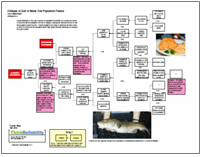By Kim Smiley
Recent estimates of the Gulf of Maine cod population show that cod is being over fished to the point that the population is at risk of collapse, meaning the numbers become so low the population cannot recover. Federal regulators are trying to determine the best course of action to protect the fish population which may include severely restricting cod fishing in the Gulf of Maine.
The declining cod population problem can be analyzed by building a Cause Map, an intuitive, visual root cause analysis. The first step in building a Cause Map is to determine what goals are impacted by the issue. In this case, the environmental goal is impacted because the cod population may collapse, but the economic impacts of this issue are also a major concern.
Cod has long been a major source of income for New England fishermen, bringing in $15.8 million in 2010. Restricting cod fishing would also impact the ability to catch other fish because cod is often also bought up in nets when other fish are targeted. Cod are bottom swimmers along with other popular fish such as flounder and haddock and it’s impossible to catch one type of fish without catching the others.
 The cod population is declining because the fish are not reproducing fast enough to keep up with fishing. Fishing of cod occurs for several reasons. First, cod is caught and sold because it is profitable. Cod meat is high in protein, low in fat and easily filleted. Additionally, federal regulations allows fisherman to catch a set quota of cod. One of the potential causes of the declining cod population may be that these quotas are set too high to for the cod population to continue to grow.
The cod population is declining because the fish are not reproducing fast enough to keep up with fishing. Fishing of cod occurs for several reasons. First, cod is caught and sold because it is profitable. Cod meat is high in protein, low in fat and easily filleted. Additionally, federal regulations allows fisherman to catch a set quota of cod. One of the potential causes of the declining cod population may be that these quotas are set too high to for the cod population to continue to grow.
The federal limits on cod fishing over the past few years were set based on information from 2008 that showed a significantly higher cod population than the estimates determined by the recent population assessment. It’s not clear why the numbers of cod varied so dramatically between the current estimates and the ones from 2008, but the dramatic swing in fish population estimates has been a source of many complaints by fishermen. It may also be worth considering whether any environmental factors have impacted the fish population. Cod population can be affect by many factors besides fishing, such as varying ocean temperatures or changes in their food supply.
After considering severe cuts of up to 82 percent, federal regulators appear to be willing to reduce the amount of cod allowed to be caught by only 22 percent for the 2012 fishing season. This is only a one year agreement and fishermen will likely face severe cuts on cod fishing limits again in 2013. At this time it’s not clear whether there is a way to save the historic fishing industry in the Gulf of Maine and ensure a healthy population of cod in the region.
To view a high level Cause Map of this issue, click “Download PDF” above.
